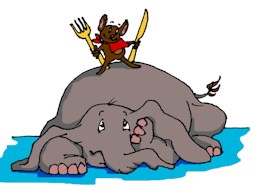Creating Your Next Big Project (And Staying Sane, and Having a Life, While Doing So)
There’s no question. Writing a book – should you ever do this – will take a big hunka outta your life.
This is why many people balk.
During book-writing, you are switching gears from immediate-income-producing actions (coaching, working with clients of any sort, speaking, etc.) to the relative isolation of being tight-focused on your book production.
Nothing will make that really easy.
There are some things that you can do, though, that will make it bearable.
This is why I’m spending so much time writing to you about your writing your blog.
Creating the Elephant for Others to Absorb (One Little Bit at a Time)
Your book will be the product that others will eat: they will consume, they will digest your book. This means that other people will decide that what you have to offer is so good that they will take the time and energy to intake your book (or your video series, your TED podcasts, your whatever).

Before your elephant of ideas can inspire your tribe, you need to feed your elephant carefully over time.
So let’s change our analogy. (Out of respect for elephants, and for people.)
People will not actually eat your elephant.
However, over time, they will absorb your elephant’s wisdom.
(There now, that’s a much cooler analogy, isn’t it?)
But before they can do that, you need to create the elephant.
That’s why I recommend blogging your way to your next book.
This Week’s Power Tip: Intralink to Pull Your Ideas Together (And Guide Your People to Connected Thoughts)
Here’s an illustration from my own work.
Two years ago, I published my second book. This publication came twenty years after publishing my first. Instead of continuing in the direction of the technical material of the first, I struck out in an entirely different direction.
Your Next Creative Endeavor Requires Incubation, Rough Creation, and Refinement
My second book was Unveiling: The Inner Journey. (And of course, it is available from Amazon, trade paper or Kindle.)
Of the twenty years that it took to create the next book, there were three major stages. If you take on a similar task, you’ll experience the same:
- Incubation – Letting the essence of your next creation emerge from your subconscious; realizing that you really are called to do the next big thing,
- Roughing It Out – Doing the research, creating first rough drafts, building and reworking the core organization – and (if needed) gaining new skills or finding a new way to write, talk, or communicate with others, and then
- Refinement – Moving from raw and rough to refined, polished, ready for publication – a stage that takes more time, energy, perseverance, and dedication than we ever want to contemplate.
Here’s a brief outline of my own timetable:
Incubation: It took me four years to catch my breath, and realize that I had a new book emerging inside me. Four years before I even realized that I wanted to write this new book.
Initial Creation: Then, it took me fourteen years to get a very raw rough draft into shape. (We’ll discuss that some other time.)
Refinement: After that, it took me 2 1/2 years to go from rough to polished to published. This was 2 1/2 years from the time that I said to myself, sitting down with all my assembled rough, “I can get this book out. There’s enough here. I’m ready.”
Even When You’re Putting Final Touches on Things, New Insights Keep Coming
Now, even though I had my rough, and was going into full-fledged edit-and-revise mode – I still kept getting new insights. (This is why blogging will come in handy for you.) Because I was focused on just getting a single product out the door, these new insights kept working their way into my book. (That’s why it took 2 1/2 years to get from rough to product, instead of my originally-projected two-to-three months.)
Making the Transition: Putting Insights into Blogs First, then Assembly into Book Later
During my revise-and-edit stage, one of the insights that I had dealt with archetypes.
I got enough material together, and organized well-enough, to get some really good new stuff into Unveiling.
However, the insights didn’t stop.
So, I began capturing them in my blog.
Regular Blogging Helps You Bring Your Ideas to Maturity
One of the most challenging concepts that I evolved had to do with the notion of a Hierophant. A Hierophant, as I found, is a transformational guide. He or she is more than a teacher. A teacher conveys known material, and measures success by the student’s absorption of this material.
A Hierophant, in contrast, deals with transforming the student – bringing that student from one state to another.
Example Hierophants include Yoda and Obi-Wan Kenobi (from Star Wars) and Mr. Miyagi (from the Karate Kid).
Over time, and in about a half-dozen blogs, I fleshed out the Hierophant concept.
Today’s Secret Weapon: Use Intralinking to Connect Your Dots
It took me months to develop enough to be clear and coherent on one new topic: the Hierophant archetype.
In a recent blog, I introduced a new archetype (Hathor, the goddess of love, sensuality, pleasure and romance). However, I brought in the Hierophant archetype in support of this new one.
At the end of the blog, I intralinked to (created links to my previous blog posts) all my previous Hierophant blogs.
Below, I show you how this looked. (The material below is taken from The Magical Turning Point – And What It Means to You (from the regular blog for Unveiling: The Inner Journey.)
Related Posts: Hierophant – Hathor’s Protector
- Our Hierophant: Mentor, Protector, and Guide for Our Love-Goddess Hathor
- Hathor or Hierophant – Who’s On Top?
- The Hierophant as Guru/Guide (also deals with Hierophant/Hathor Connection)
- Are Hierophants Really That Important? (McDonald’s Thinks So!)
- Who – and What – Is a Hierophant?
- The Hero’s Quest and the Hierophant – Part 1
You can see from the above example (six intralinks or links to other blog posts, taken from a different blog) that I culled out six different blogposts on the Hierophant concept. They range in posting date from last week (the most recent) to about this time, two years ago. (They’re listed chronologically; most recent first.)
That’s two years of developing a single concept over time.
You can see the evolution of thought.
The first blog post is the one at the bottom of the listing – The Hero’s Quest and the Hierophant – Part 1. It reads almost as a teaser; I don’t really divulge anything about the Hierophant concept itself. However, I do set a lot of context – and this is important when introducing a new idea. This was approximately two years ago today; September 22nd, 2011. (Today is September 25, 2013).
A week later, in the next blogpost (Who – and What – Is a Hierophant?), I introduced a first definition – a first pulling out of the Hierophant concept in a useful way. If you read this one, you’ll see that I was still sort of groping towards definition-by-examples.
In the next two blogposts (Are Hierophants Really That Important? (McDonald’s Thinks So!) and The Hierophant as Guru/Guide (also deals with Hierophant/Hathor Connection)), you’ll see that I was getting clearer – the whole Hierophant notion took on more crispness, as I found more examples through reading books and talking with people.
These early blogs were a lot like my approach to writing my first book, when I wrote a set of “annotated bibliography” columns for a highly specialized computer science journal. They were expostulation. I was developing and framing a new idea, and using the blog to flesh it out for myself. Readers benefited – but at this stage, I was still really writing more for myself than for them.
Then, I began to look at the connection between the Hierophant and other archetypes. That started a whole exploration. Once again, I was back to early-stage expostulating. (For this, see two blogs – Hathor or Hierophant – Who’s On Top? and a blog that followed shortly therafter, Our Hierophant: Mentor, Protector, and Guide for Our Love-Goddess Hathor.) These were written a little over two years ago; March of 2012.
By now, I was getting some solid content – material that could be used to generate a rough and raw draft for a new book. (See my blog in this series from two weeks ago; How to Write Your Book by Writing Your Blog.)
Finally, I began to get some real crispness – not only about the Hierophant notion, but also how this archetype “played with others.” (Specifically, how this archetype interacted with the Hathor-goddess archetype; see The Magical Turning Point and What It Means for You.)
In this last blog, you’ll see that my concepts are clearer – they are more well-defined, their relations with others are clearer. My writing style is less going through my personal journey, and more authoritative.
In short, it took a two-year timeframe to clearly bring out and define one concept.
Yes, there are other concepts and works that I’ve brought out in the same timeframe.
What you’re seeing here, though, is the time that it takes to bring your ideas to maturity.
Translating: From My Experience to Your Writing (and Your Idea-Generation)
Your first blogs on a subject will be exploratory. You may just be sensing that something is ready to emerge, and setting context. Think of yourself as an artist, working with oil paints. Your first step will be rough pen-and-pencil or charcoal drafts, or quick sketches. Then, you’ll prep the canvas.
Then, your next few blogs on that subject will give it tentative rough shape. In “artist’s terms,” you’re blocking out the main figures.
After that, your work focuses on connecting your concepts to one another. How do they support? How do they interconnect? How do they, taken together, build a larger whole?
If you were an artist, this would be the time in which you’d work on connecting visual flow; making sure that colors, patterns, or motifs in one area connect to another.
Finally, you come to the finishing work.
As a writer, though, what you’ve brought forth in your blogs is simply the core element of your ideas and concepts. Taking them into book form, or making them ready for broader dissemination, is an entirely new stage.
The point is: by using your blog, you’ve generated, fleshed out, and developed your new and significant intellectual contributions. You know what you know.
This is a good place.
To your health, wealth, and well-being –
Alianna



Pingback: Doubling Your Readership Base: A “Power Tip” | Mourning Dove Press